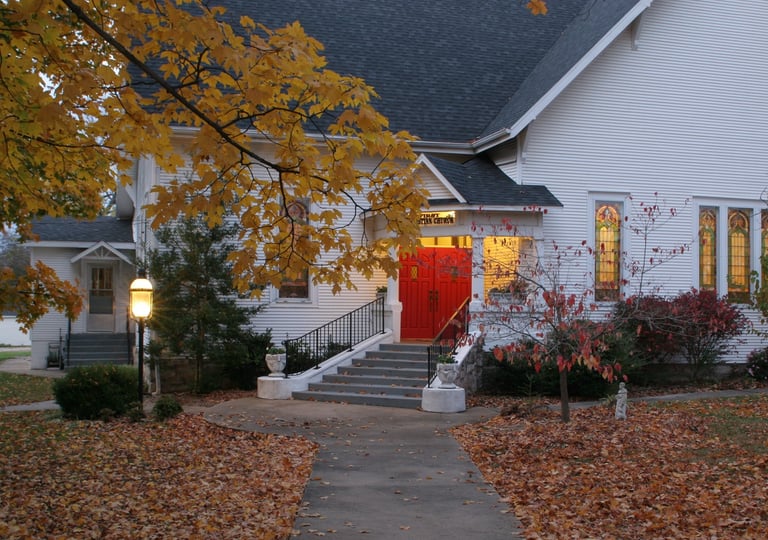Our Church History
The history of our church is a rich tapestry woven with devotion, community, and faith. Established in 1871, First Christian Church has been a cornerstone of our community, providing spiritual guidance and support to generations of families.
From its humble beginnings, the church has grown both in size and influence, fostering a sense of belonging and purpose among its congregation. Significant events, such as community outreach programs and holiday celebrations, have marked our journey, creating lasting memories and bonds.
The architecture of the church, with its stained glass windows and welcoming facade, reflects the spirit of the community it serves.
As we look back on our history, we are reminded of the unwavering commitment of those who came before us and the importance of continuing their legacy of love and service. Today, we stand united, ready to embrace the future while honoring our past.
A very special "thank you" goes to Dave Buttgen for compiling the church history you will read below. Thank you Dave!
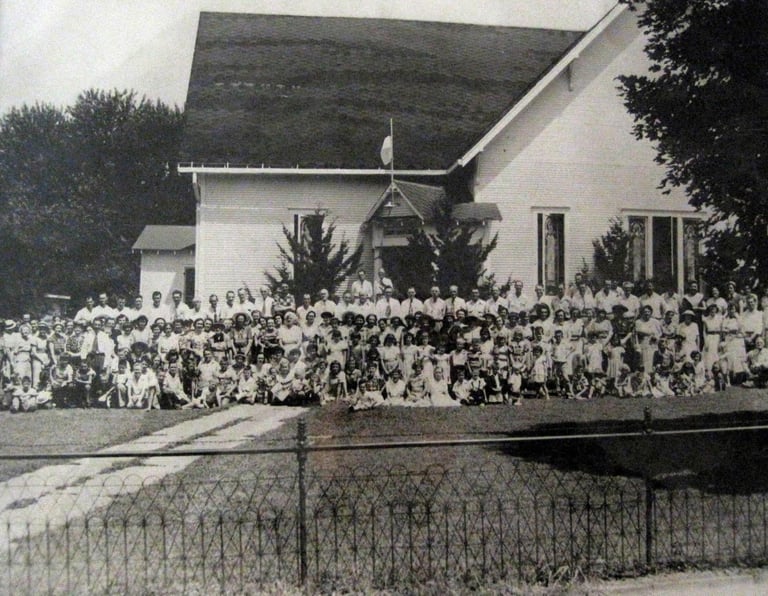

And so it began.....
There is no greater influence on the lives of people in any community than that of the church. The first church services were held near the Old Mill Spring by itinerant ministers. All denominations worshipped together. The many beautiful churches that are located in this area are a testimony to the influence of those early pioneers.
In the aftermath of the Civil War, the Berryville community growth was slow but steady. It was during this time that the first steps were taken towards the establishment of our present-day Christian Church. It is unknown where the congregation worshipped in the early years. Because it wasn’t until October of 1871 that a series of formal planning meetings were held to build a church. From those meetings came, from each family, pledges of time, money and talents towards the creation of their new church.
The planners were strongly influenced by the Christian movement (also called the Disciples of Christ) that began in Arkansas in the 1830s. The early history of The Christian Church (Disciples of Christ) is shared by two other groups: The Church of Christ and the independent Christian Churches/Churches of Christ. They all emerged from the same roots. The Stone-Campbell movement began as two separate threads, each without knowledge of the other in the early 19th century. The first, led by Barton W. Stone began at Cane Ridge, Bourbon County, Kentucky. The group called themselves simply Christians. The second began in western Pennsylvania and West Virginia, led by Thomas Campbell and his son Alexander Campbell.
Both movements sought to end the divisiveness that often comes with denominational differences. They wanted to found the unity of the church in the simple acknowledgement that Jesus is the Christ, the Messiah, and an acceptance of Him as Lord. Both were opposed to the use of creeds as a test of faith. They believed that the simple confession that Jesus Christ is Lord was sufficient to unite all Christians. They considered man-made creeds divisive.
Following World War II, the two churches agreed that they could no longer effectively meet the needs of the postwar era as a single organization. Discussions throughout the 1950s and 60s led to an International Convention of Christian Churches which adopted a plan to restructure the entire organization. In 1968, the modern-day Disciples of Christ was born.
The First Christian Church was then organized as the Church of Christ. The members agreed to be governed in their faith by the word of God alone. The elders were W.C. Stephens and M.W. Fisk. Deacons were W.A. Bonner and S.B. Meek. On December 21, 1877, a pledge document was signed by eighteen church members to pay for the property, as well as labor, lumber and building supplies “for the purpose of erecting a church house in Berryville, Arkansas to be known as the Church of Christ”. This document has been preserved, and is currently framed and displayed in the church’s narthex. According to a recorded deed dated September 24, 1878, Trustees J. C. Hanna and T. C. Freeman paid J. W. Freeman and his wife ten dollars for land to build their church. The property was approximately one-fourth of an acre and located on Church Street. This was one of the first streets named in Berryville’s original plat.
The church was completed in 1879; four years after Berryville became the county seat of Carroll County, and three years after the city was incorporated.
As county seat, the community thrived and built the first county courthouse on the Public Square in 1880. Shortly thereafter, a new Union Church was built in 1882. By the end of the 19th century, a water tank was constructed near Berry Spring to supply the growing community with fresh water. In 1901, Berryville became part of the St. Louis and North Arkansas Railroad connecting the community to Eureka Springs and Harrison.
There is no record of the number of charter members nor is the name of the minister recorded. The oldest available record only goes back to 1911. It states that during this year an addition was built on the church building. The report for 1912 gives the resident membership as 127. The church property at this time was valued at $4,000.00 and I. H. Burgess was the minister. He served half time at a salary of $600 per year.
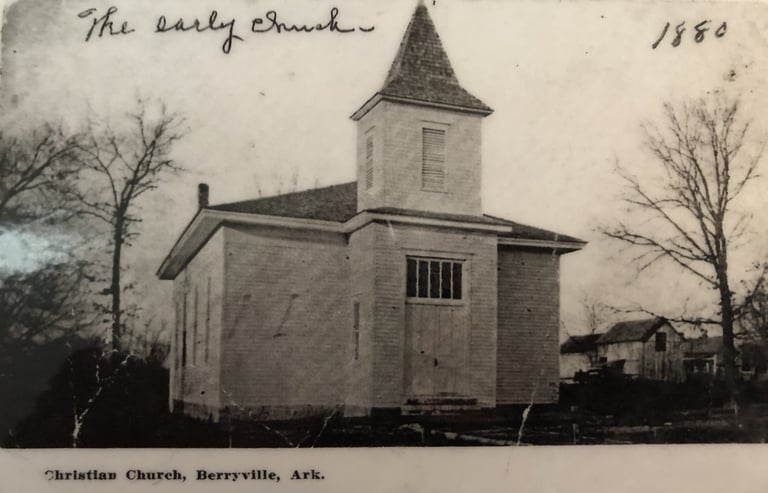

The original 1879 structure still remains the core of the church complex. According to Sanborn maps and historic pictures, the original structure was a one-story frame building with a rectangular footprint, front-gabled with an outset central tower on the front (south) façade. The front entrance was through double-doors in the tower that included transom windows and terminated with a 35-foot spire. The building had horizontal clapboard siding, wood shingles, and double-hung, four-over-four windows on the east and west (side) elevations.
The church has Carpenter or Rural Gothic architectural elements, which is representative of many houses and small churches within rural America during the late 19th and early 20th centuries. This style includes picturesque massing applied to wooden structures, and is relatively unadorned except for some craftsman-style elements. These elements are reflected in the exposed brackets and rafter tails under the overhanging eaves, hand-crafted foundation stonework, and a covered front porch supported by octagonal-shaped wood columns.
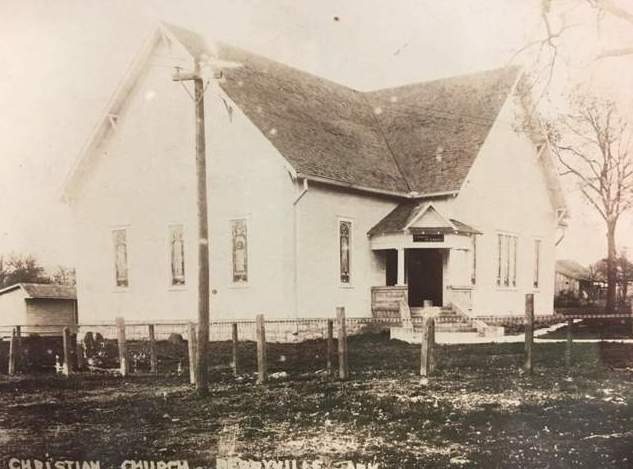

The building remained unchanged until 1911 when a twenty foot “extension” was added on the north (rear) elevation of the church. This new space included a baptistry and two classrooms. The annual report as of December 1, 1912, revealed the church was valued at $4,000.00. According to Sanborn maps, electricity was installed sometime between 1909 and 1914.
The church still retains most of its original features from the 1915-1925 alterations. Church records indicate that in 1917 the congregation raised $3,000 for church improvements, which according to Sanborn maps, were made sometime between 1915 and 1925. These extensive improvements included a 24’ x 35’ addition on the west side that included a narthex, church office, and vestibule. A 16’ x 35’ raised addition on the east side was built to expand the sanctuary. This expansion allowed space for chancel space for the minister and choir. The front tower and spire were removed. The front entrance was relocated at the corner intersection of the new west addition and the original building. That entrance now faces southwest. There are two entrances: southwest allowing access to the vestibule and the other in the east addition allowing access directly into the sanctuary. This entrance was later eliminated in the 1970s. Historic photographs show the building had horizontal clapboard siding and wood shingles.
There were no major improvements until late 1949 and early 1950, when an addition was built on the northwest (rear) elevation. This addition included a full kitchen, dining hall, ladies bathroom and two classrooms. The foundation for this addition was poured concrete. A “cry room” was also created in the narthex directly behind the sanctuary, with a large picture window facing the sanctuary. This space allowed parents with crying children to view and hear the service in a secluded, enclosed room. Additional improvements at this time included rewiring of the entire building. A new public address system was installed. Asphalt shingles were installed over the original wood shingles. The two stained glass windows located on the north (rear) façade of the building were removed and relocated to interior walls of the church sanctuary. Dedication of these improvements was held on February 19, 1950 with a price tag of $3,987.60.


Over the next fifty years there were minor improvements and several notable alterations. In order to create a choir room, an interior wall was built on the east end of the chancel, which spanned the full width of the space (north to south). The other notable alterations included a small vestibule addition on the north (rear) of the building and handicap ramp in 1985, and the installation of vinyl siding over the original clapboard siding in 1990. The interior wood floors are covered with carpet and the interior plaster walls have been covered with stucco-type finish and faux-wood paneling.
Another significant interior feature is the baptistry. Located in the northeast corner of the sanctuary near the chancel. It is framed with wood-trimmed arched openings and appears to have been constructed at the same time as the 1915-1925 alterations. The stained glass panels surrounding the baptistry were installed in 1978 in memory of Rev. Robert Sanders.
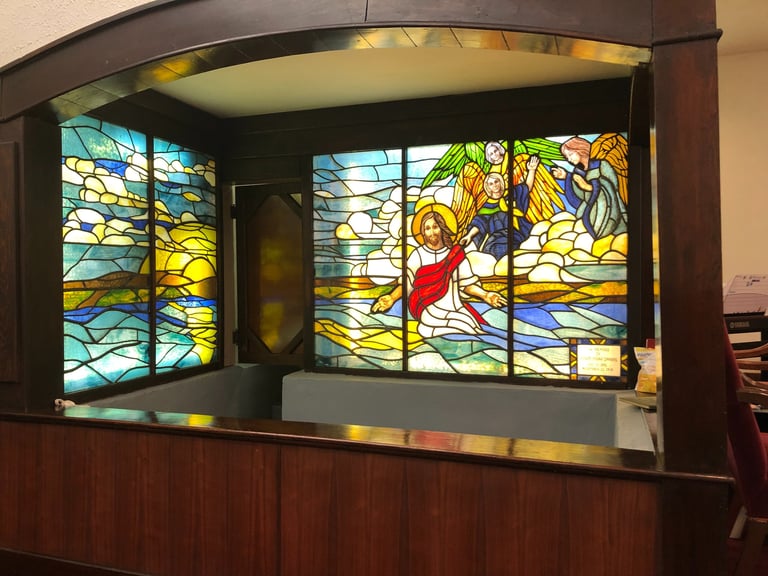

In 2000, an L-shaped addition was constructed on the northeast (rear) elevation of the building, which included a corridor, choir room, handicapped bathroom, and sacristy. Around this time the interior wall on the east end of the chancel was also removed. It was returned to its original location.
From the south (front) elevation, the church looks very similar as it did at that time, with the front gabled central section, two wide wing additions, and cement staircase that leads up to the front porch covered by a steeply pitched gable roof. It retains fourteen of the seventeen original stained glass windows on the south, east, and west elevations. Three windows on the north (rear) elevation were removed when rear additions were constructed and have been relocated to interior walls. These stained glass windows reflect an Arts and Crafts style, with a simple organic design in earth tones.
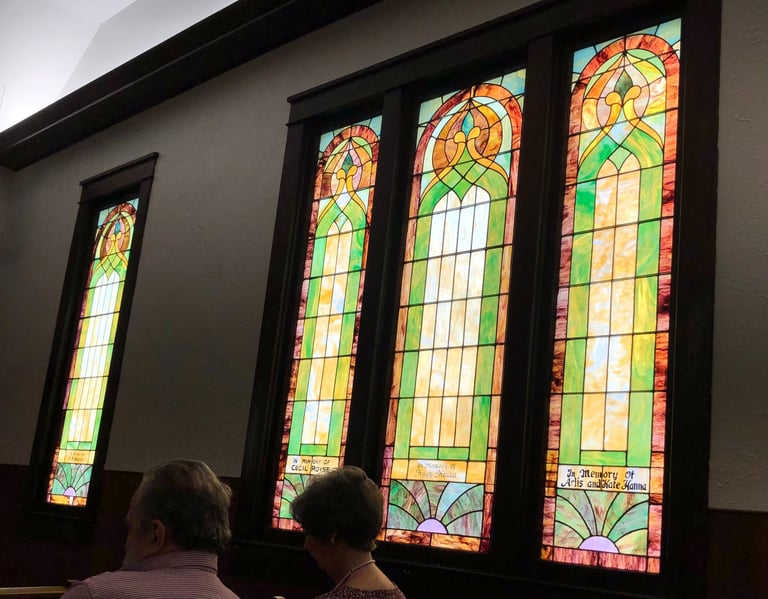

October 1913, under the leadership of Brother Burgess, the church organized a congregation in the community of Walnut Grove. With an initial membership of 29, the church flourished for a time. Several members moved away. The remaining members transferred to the Berryville congregation.
1914 saw a rise in the membership to 239. Through attrition (members moving away and deaths) the membership dropped to 146. Church value had risen to $5,000 and the half-time minister Rev. Burgess salary to $480 per year.
In October 1942, a devastating tornado hit Berryville and killed 28 people and seriously injured 68. Although many buildings were damaged, it is unknown how the tornado affected the church. A housing shortage ensued and the church’s minister was forced to resign due to his inability to find a suitable rental home in the community. Realizing the seriousness of the situation, the church leaders bought a parsonage in 1944. It was located on nearby Springfield Street. The building was later sold in 1960.

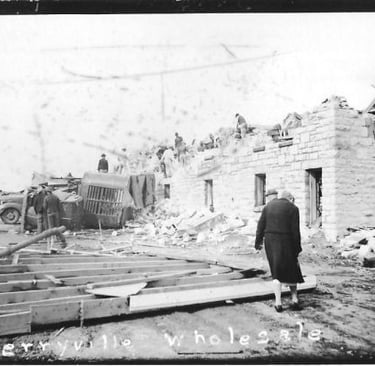
By the end of the 1940s, changes began to take place within various Christian denominations across the country. Up until this time, the Disciples of Christ, Church of Christ, and independent Christian Churches/Church of Christ, shared a unified history and common doctrine. However, by 1947, Berryville’s Church of Christ congregation determined they had to make a change. According to church records, on June 13, 1947, the church went on record as withdrawing all support from the Disciples and their agencies, and “all other agencies which are not in harmony with Christ and the Scriptures.” That same year, the church was incorporated under the name of First Christian Church, and a new “Christian Church” sign was installed above the front entrance replacing the former “Church of Christ” sign.
Also, during the year 1947 the church joined with the Berryville Telephone Company to form a “Conditional Sales Agreement” to sell the southwest corner of the church property. The “condition” was that if the Berryville Telephone Company or any of its iterations were to no longer need the property, the building and the land would return to the church. Which it did in 1968.
Less than ten years later on January 15, 1956, the church congregation voted to repeal the resolution of June 13, 1947, therefore maintaining their ties with Disciples of Christ.
Rev. Delmar F. Poe was called as minister November 07, 1948. In 1949 and 1950 a 23’ x 43’ addition was made. Its main features were the installation of a modern kitchen and a “cry room”. All the class rooms were remodeled and two new class rooms added. A ladies restroom was added and a new roof was installed on the northwest side of the building. The entire building was rewired. There were 165 resident members.
In 1968, the Allied Telephone Company returned, per contractual obligation, the old Berryville Phone Company building just west of the main church entrance. Over the years it has been used as a thrift store and offices of the Carroll County Literacy Council. Currently it is being used by our beloved Choir Master, David Bell, as an office for his Cruise the Ozarks publication.
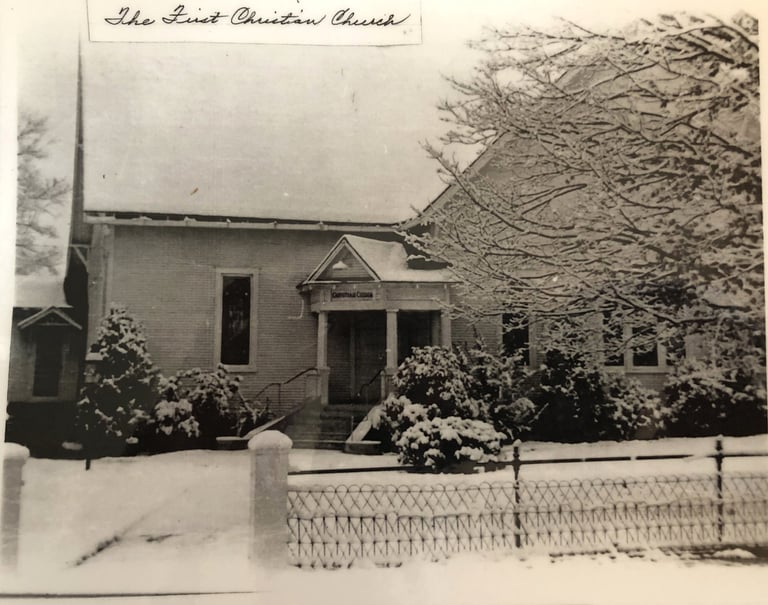

In 1971, the church congregation celebrated their centennial. The Berryville community was invited to attend the celebration, which included special church services, an open house and a reception. Brass plaques bearing the names of former members were donated by current members, and are still on display in the southwest corner of the sanctuary. The church carries on this tradition.
In the 1980’s, artist and pastor emeritus of the First Presbyterian Church in Berryville, Hal Mallett, created a series of four paintings of the church representing the four seasons. These paintings hang in the church foyer and are the subject of greeting cards that can be purchased through the church office.
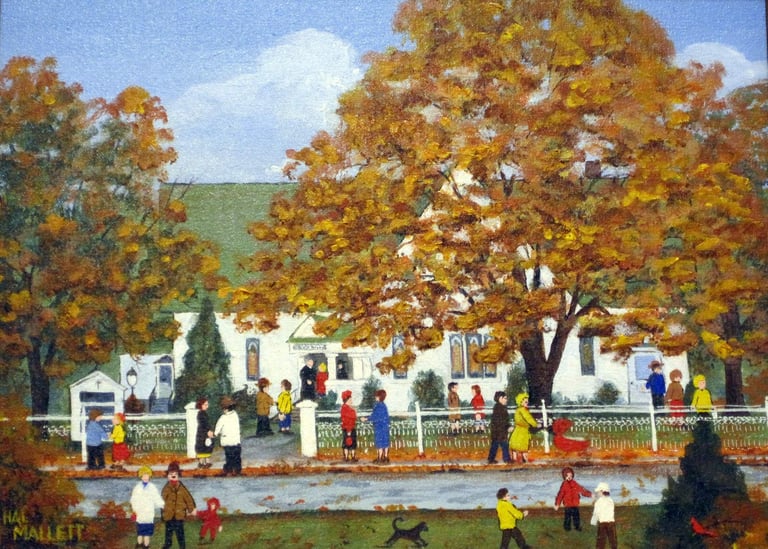

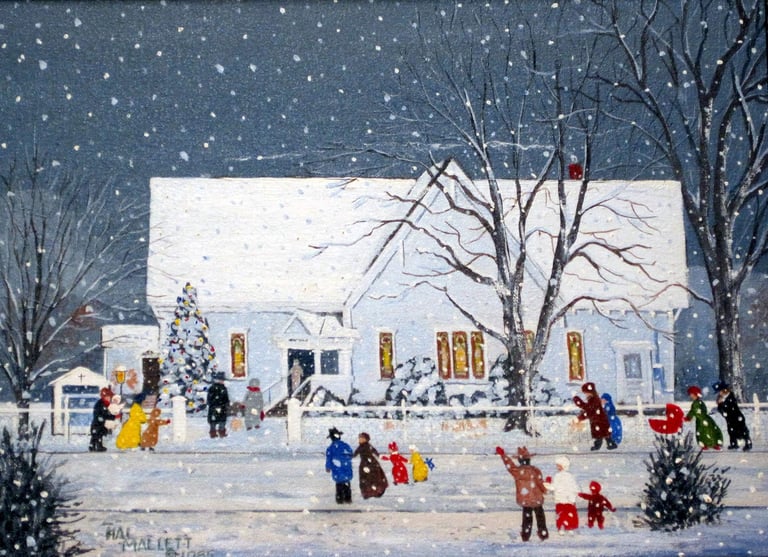

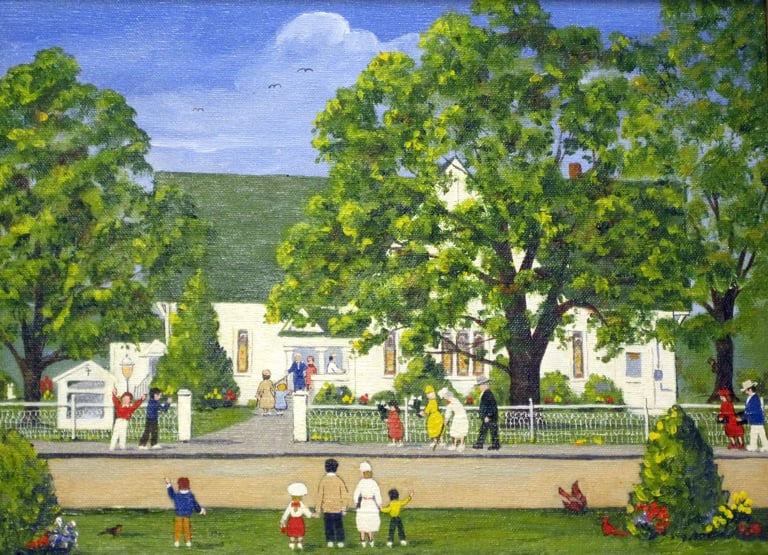

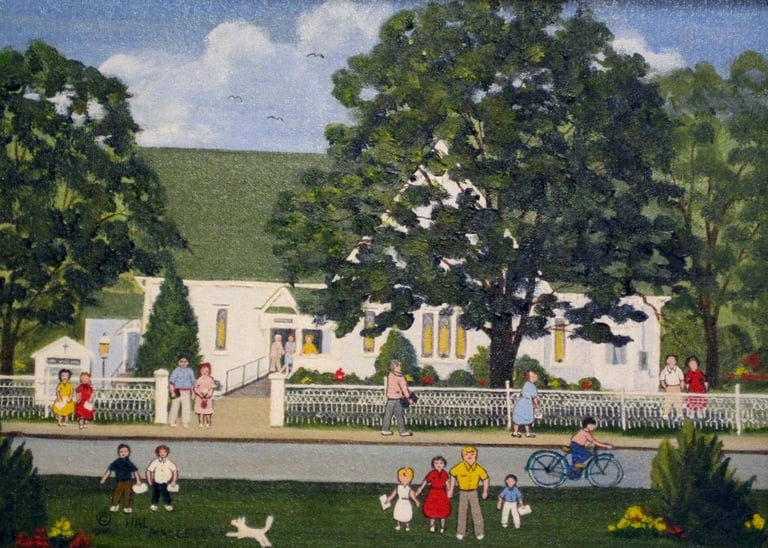

The Christian Church (Disciples of Christ) is truly an American church originating in this great land and being rooted in freedom’s cause. It is the largest movement originating on American soil. The First Christian Church of Berryville, Arkansas is the oldest continuously operated church in the community.
Throughout our 150 years of history, The First Christian Church of Berryville, Arkansas has focused on families, on close fellowship among members, and on being the best people we can be as we follow Christ’s command to Love God with all our heart and to Love our Neighbors as ourselves.
